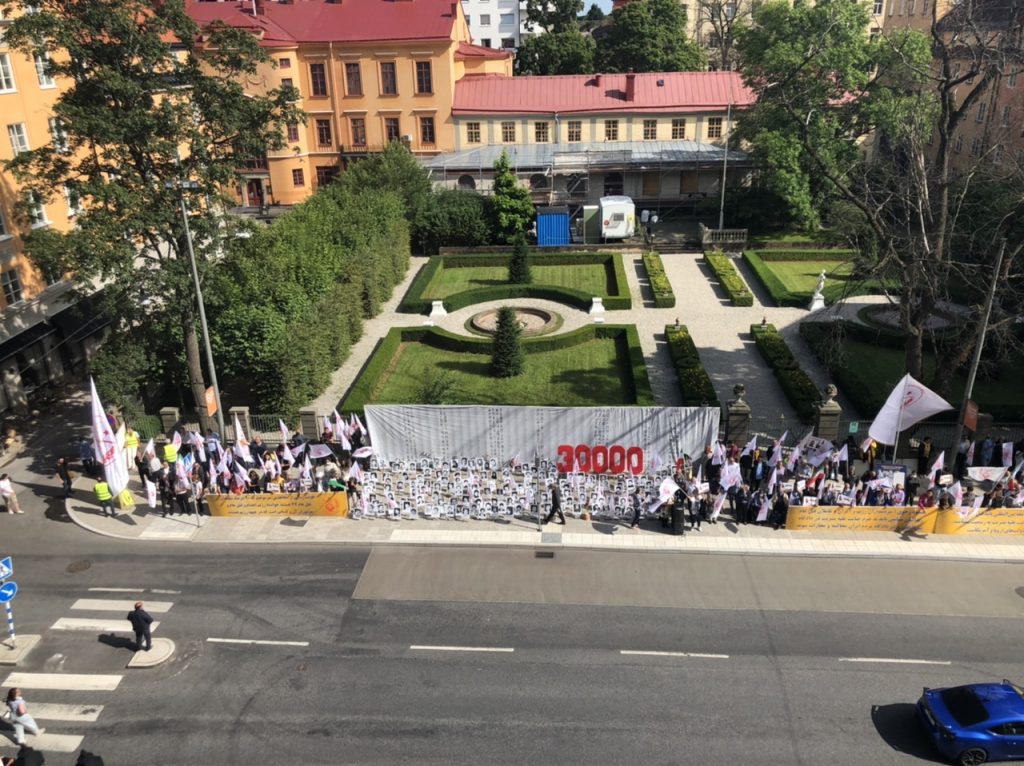Report 2: First Week of Trial Concluded

On Tuesday last week, the long-awaited trial against an Iranian national suspected of war crimes began in Stockholm District Court. The defendant stands accused of war crimes and murder for his alleged involvement in the mass-execution of political prisoners in Iran during the summer of 1988.
Stockholm District Court is located in the central parts of Stockholm, in the borough of Kungsholmen, and was established in 1971 as part of a wider reform of Swedish courts. The building was designed by architect Carl Westman and was inaugurated in 1915, then functioning as a city hall.
Tuesday was a bright, sunny day in Stockholm and with proceedings set to begin at 9.15 AM, a crowd numbering in the lower hundreds lined the streets around the court. Across from the court’s main entrance, large pictures of men and women executed in the summer of 1988 adorned a fence and offered a stark reminder of the magnitude of the massacre and the suffering of those effected.
Many in the crowd held up signs with pictures of relatives who were executed. Others held signs expressing their sympathy for the victims and calling for those involved in the massacre to be brought before justice. Various grassroots organisations were on site as well. A large group affiliated with the Mojahedin-e-Khalq (MEK), the organisation many of those executed sympathized with, was present too, with banners and flags bearing the organisations symbol on display.
The arrest and subsequent prosecution of the defendant has already garnered extensive media coverage and on the opening day of the trial, the widespread interest in the case was apparent with reporters from several international news organisations gathered outside. Inside the court, the trial is being held in the room 37. With only a small number of seats available, reserved for a few injured parties and the media, the court has made an additional room in the main building available for other injured parties and Farsi language media with interpretation provided by link. In addition, many of the injured parties are following the trial by link from Albania and elsewhere in the world. A room in an adjacent building has also been made available to enable members of the public to follow the trial through video link. Security guards in the entrance to the respective rooms are all fluent in Farsi.
Judge Tomas Zander is presiding over the case, and as doors closed to room 37, the defendant was escorted in by a couple of guards, with handcuffs on and accompanied by his two court appointed defense lawyers. Wearing a tucked in white shirt, he greeted the room with a smile and a ‘good morning’ in Swedish. The prosecution is represented by a team of three, led by chamber prosecutor Kristina Lindhoff Carleson, with four plaintiff’s counsels representing different groups of injured parties. Two interpreters share the duty of translation, ensuring the defendant and non-Swedish speaking injured parties can understand what is being said.
As proceedings began, with the prosecution and plaintiff’s counsels shortly presenting their claims, the defendant, as expected, denied all charges. Following those formalities, judge Zander allowed the prosecution to begin its opening presentation of facts, with the four first days of trial entirely dedicated to the prosecution’s presentation. Each day of trial begins at 9.15 AM, with lunch scheduled for 12 to 1.30 PM, and fifteen-minute breaks both in the morning and in the afternoon. The prosecution’s opening presentation consists of different ‘chapters’, ranging from basic information on Iran to arguments on which articles and conventions are applicable in the case, and is presented orally, but aided by a series of Powerpoint slides outlining the main points of each chapter and sub-chapter.
On the afternoon of day two, the trial was shortly halted as judge Zander felt that chanting from the crowd, which yet again had gathered outside the court, was a disturbance to the court and with the defendant claiming that hearing the chants “felt like torture”. Day three was also cut short for unspecified reasons. With the three first days of the trial finished, and with the prosecution’s opening presentation scheduled to continue for at least another day this week, a report with an extensive review and analysis on the presentation will follow once the prosecution rests and will be found here.
A translated version of this report in Farsi can be found here.
